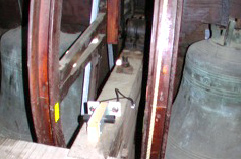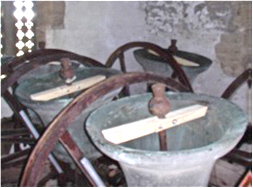What is a Ringing Simulator?
By Tom Harris of Staplegrove
Many people will know the answer to this question. So if that applies to you, skip this section and spend the time saved on the basic twenty four part Readers Digest course on Origami for Insomniacs, or something similar.

Sensor attached to wheel and frame
It’s probably better to consider the answer from the angle of what a simulator does. Essentially, from the point of view of a learner, it enables you to clatter around endlessly, practicing anything, but leaving the neighbours completely undisturbed, even totally unaware, while you still hear the sound of your ringing through gently moderated loud speakers in the ringing room.

Clapper fixed to stop movement
Soundless ringing is made possible by temporarily tying or fixing the bell clapper so it does not strike the bell as the whole is swung (R). Prior to this sensors will have been permanently attached to all the bell wheels and the corresponding bell frames (L), such that when the wheels rotate the wheel sensors closely pass the fixed sensors on the main bell frame. This momentary passing sends a signal via cabling down to a small computer, usually a lap-top, in the ringing room. The computer has to be enabled with a ringing program such as Abel©. This, when set up, in response to the signals from the belfry sensors will pass the computer generated sound of each bell as it rings via an amplifier to the speakers. The timing of the speaker sound in the ringing room is as near as is humanly possible to achieve to the actual time when in normal ringing you would expect to hear the sound of your bell if really striking. The volume in the ringing room can obviously be adjusted to taste, which is rather nice.
A simulator may also be used by a single person, pairs, or numbers less than a traditional full band, to enable extra practice, with the other unmanned bells being rung electronically, or, more commonly, by six or more actual ringers working together for group training. The computer is simply programmed to function as the ringers present require. Various bell styles from a typical parish church sound or a full scale cathedral ring can be achieved, though
whatever emerges does require a leap of imagination and, I am reliably informed that, just for laughs dogs barking or ducks quacking can be programmed in, though I have no personal experience of that!
